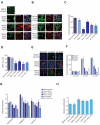Family-wide investigation of PDZ domain-mediated protein-protein interactions implicates β-catenin in maintaining the integrity of tight junctions
- PMID: 23790492
- PMCID: PMC3728706
- DOI: 10.1016/j.chembiol.2013.04.021
Family-wide investigation of PDZ domain-mediated protein-protein interactions implicates β-catenin in maintaining the integrity of tight junctions
Abstract
β-catenin is a multifunctional protein that plays a critical role in cell-cell contacts and signal transduction. β-catenin has previously been shown to interact with PDZ-domain-containing proteins through its C terminus. Using protein microarrays comprising 206 mouse PDZ domains, we identified 26 PDZ-domain-mediated interactions with β-catenin and confirmed them biochemically and in cellular lysates. Many of the previously unreported interactions involved proteins with annotated roles in tight junctions. We found that four tight-junction-associated PDZ proteins-Scrib, Magi-1, Pard3, and ZO-3-colocalize with β-catenin at the plasma membrane. Disrupting these interactions by RNA interference, overexpression of PDZ domains, or overexpression of the β-catenin C terminus altered localization of the full-length proteins, weakened tight junctions, and decreased cellular adhesion. These results suggest that β-catenin serves as a scaffold to establish the location and function of tight-junction-associated proteins.
Copyright © 2013 Elsevier Ltd. All rights reserved.
Figures






References
-
- Abbosh PH, Nephew KP. Multiple signaling pathways converge on beta-catenin in thyroid cancer. Thyroid. 2005;15:551–561. - PubMed
-
- Bilder D, Perrimon N. Localization of apical epithelial determinants by the basolateral PDZ protein Scribble. Nature. 2000;403:676–680. - PubMed
-
- Blankesteijn WM, van Gijn ME, Essers-Janssen YP, Daemen MJ, Smits JF. Beta-catenin, an inducer of uncontrolled cell proliferation and migration in malignancies, is localized in the cytoplasm of vascular endothelium during neovascularization after myocardial infarction. Am J Pathol. 2000;157:877–883. - PMC - PubMed
Publication types
MeSH terms
Substances
Grants and funding
LinkOut - more resources
Full Text Sources
Other Literature Sources

